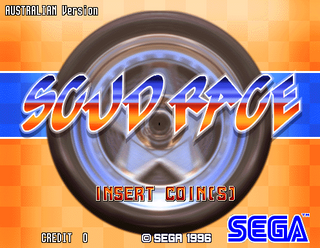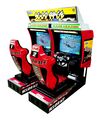Difference between revisions of "Scud Race"
From Sega Retro
| Line 85: | Line 85: | ||
==Production Credits== | ==Production Credits== | ||
'''Producer & game director:''' [[Toshihiro Nagoshi]]<br> | '''Producer & game director:''' [[Toshihiro Nagoshi]]<br> | ||
| − | '''Programmers:''' Takuji Masuda (program director), Kouki Koiwa, Takashi Fujimura, Kazuhiko Takata, Takashi Isowaki, Takayuki Kazama, Ryo Ikawa<br> | + | '''Programmers:''' [[Takuji Masuda]] (program director), [[Koki Koiwa|Kouki Koiwa]], [[Takashi Fujimura]], Kazuhiko Takata, [[Takashi Isowaki]], [[Takayuki Kazama]], [[Ryo Ikawa]]<br> |
| − | '''Designers:''' Yasuo Kawagoshi (design director), Daisuke Sato, Akihito Hiroyoshi, Junichi Yamanaka, Yukinobu Arikawa, Makio Kida, Kazufumi Ohashi, Hidenobu Miyakita, Junichi Yamada, [[Makoto Osaki]], Kazuhiro Izaki, Naotake Nishimura, Shinichiro Shimano<br> | + | '''Designers:''' [[Yasuo Kawagoshi]] (design director), [[Daisuke Sato]], [[Akihito Hiroyoshi]], Junichi Yamanaka, [[Yukinobu Arikawa]], [[Makio Kida]], [[Kazufumi Ohashi]], Hidenobu Miyakita, [[Junichi Yamada]], [[Makoto Osaki]], [[Kazuhiro Izaki]], [[Naotake Nishimura]], [[Shinichiro Shimano]]<br> |
'''Sound:''' [[Hideaki Miyamoto]], [[Tohru Nakabayashi|Toru Nakabayashi]], [[Fumio Ito]], [[Hidenori Shoji]] | '''Sound:''' [[Hideaki Miyamoto]], [[Tohru Nakabayashi|Toru Nakabayashi]], [[Fumio Ito]], [[Hidenori Shoji]] | ||
* '''Digital Media Studio:''' [[Tatsutoshi Narita]], [[Naoyuki Machida]] | * '''Digital Media Studio:''' [[Tatsutoshi Narita]], [[Naoyuki Machida]] | ||
| − | * '''YUMEX:''' Junji Fujita, [[Kaoru Ohori]], Hiroko Hamano | + | * '''YUMEX:''' [[Junji Fujita]], [[Kaoru Ohori]], Hiroko Hamano |
| − | '''Cabinet Engineers:''' Masao Yoshimoto (mechanical supervisor), Eiji Nishimura, Eiji Inoue, Yumiko Ara, Hiroyuki Takahashi, Hideyuki Yamada, Mikio Tsuda, Keisuke Tsukahara<br> | + | '''Cabinet Engineers:''' [[Masao Yoshimoto]] (mechanical supervisor), [[Eiji Nishimura]], [[Eiji Inoue]], [[Yumiko Ara]], [[Hiroyuki Takahashi]], [[Hideyuki Yamada]], Mikio Tsuda, Keisuke Tsukahara<br> |
| − | '''Publicity:''' Koji Umeda<br> | + | '''Publicity:''' [[Koji Umeda]]<br> |
'''Special Thanks:''' BPR Organization, Japan Airlines, Car Graphic, S.S. Company ltd., Cobra Company Japan, [[Yu Suzuki]]<br> | '''Special Thanks:''' BPR Organization, Japan Airlines, Car Graphic, S.S. Company ltd., Cobra Company Japan, [[Yu Suzuki]]<br> | ||
'''Presented by:''' [[Sega]]<br> | '''Presented by:''' [[Sega]]<br> | ||
Revision as of 21:19, 24 April 2012
| Scud Race | |||||
|---|---|---|---|---|---|
| System(s): Sega Model 3 Step 1.5 | |||||
| Publisher: Sega | |||||
| Developer: Sega AM2 | |||||
| Genre: Racing | |||||
| Number of players: 1-4 | |||||
|
Scud Race, known as Sega Super GT in North America, is a racing game developed by Sega AM2 for Sega Model 3 Step 1.5 hardware in late 1996. The first Model 3 racing game, Scud Race is a spiritual sequel to Daytona USA with very similar controls, HUD and visual style, though features supercars rather than NASCAR-style stock cars. The working title of this game was simply Supercar, though European flyers suggest that at one point the Scud Race name wasn't deemed final either. "Scud" stands for "Sport Car Ultimate Drive".
Scud Race was likely intended to show off the capabilities of the Model 3 hardware as it contains many bright, colourful and detailed stages all played through at fast speeds while retaining the 60FPS refresh rate. The core engine powering the game does not differ significantly from Daytona USA due to supposed time restraints - major improvements would not be seen until Daytona USA 2: Battle on the Edge.
Contents
Gameplay
Scud Race follows the same basic rules as Daytona USA in terms of gameplay as they both share the same game engine - it is a racing game in which the player competes against several dozen computer controlled cars in an attempt to finish first. As an "arcade style" racer, much of the "realism" is taken out of the equation in order to provide the user with a fast paced, entertaining experience - cars do not handle like they would in reality, but rather how users would want these cars to handle.
Like Daytona USA, Scud Race is based on a real life racing event - the BPR Global GT Series, being sponsored by the BPR Organization. It also features four real-life cars - the Porsche 911 GT2, the Ferrari F40 GTE, the Dodge Viper GTS-R and the McLaren F1 GTR, all of whom could be spotted in the 1995 season. Renault Alpine GTA/A610s are also featured, but are driven by the computer and cannot be selected by the player.
One of the only major changes of Scud Race is the drifting system, as players can now accelerate while drifting.
Cars
Tracks
Sequels and Rereleases
Scud Race was due to be ported to the Sega Saturn, though the vast differences in hardware capabilities meant development moved over to the Sega Dreamcast (similar to Virtua Fighter 3). The Dreamcast version of the game was used in a tech demo in the 1998 Dreamcast Presentation, but the port was cancelled for unknown reasons. Some Dreamcast development kits have sections of Scud Race built in for example purposes.
Unlike Daytona USA, the BPR Global GT Series no longer exists as a sport (and in fact, was discontiuned in 1997 - a year after Scud Race's release), and so may explain why Scud Race was never brought to home consoles. GT racing games (such as Sega GT and its sequels) would stil lbe released by the company in the years that follow, but none follow the "arcade style" gameplay seen here.
Despite seeing no console release of its own, the four tracks in Scud Race appear in the Xbox port of OutRun 2, complete with original music. An updated version of the game, Scud Race Plus and an official soundtrack would be released in Japan.
Production Credits
Producer & game director: Toshihiro Nagoshi
Programmers: Takuji Masuda (program director), Kouki Koiwa, Takashi Fujimura, Kazuhiko Takata, Takashi Isowaki, Takayuki Kazama, Ryo Ikawa
Designers: Yasuo Kawagoshi (design director), Daisuke Sato, Akihito Hiroyoshi, Junichi Yamanaka, Yukinobu Arikawa, Makio Kida, Kazufumi Ohashi, Hidenobu Miyakita, Junichi Yamada, Makoto Osaki, Kazuhiro Izaki, Naotake Nishimura, Shinichiro Shimano
Sound: Hideaki Miyamoto, Toru Nakabayashi, Fumio Ito, Hidenori Shoji
- Digital Media Studio: Tatsutoshi Narita, Naoyuki Machida
- YUMEX: Junji Fujita, Kaoru Ohori, Hiroko Hamano
Cabinet Engineers: Masao Yoshimoto (mechanical supervisor), Eiji Nishimura, Eiji Inoue, Yumiko Ara, Hiroyuki Takahashi, Hideyuki Yamada, Mikio Tsuda, Keisuke Tsukahara
Publicity: Koji Umeda
Special Thanks: BPR Organization, Japan Airlines, Car Graphic, S.S. Company ltd., Cobra Company Japan, Yu Suzuki
Presented by: Sega
Gallery
Artwork
Physical Scans
Template:ScanflyerTemplate:ScanflyerTemplate:ScanflyerTemplate:ScanflyerTemplate:ScanflyerTemplate:ScanflyerTemplate:Scanflyer




